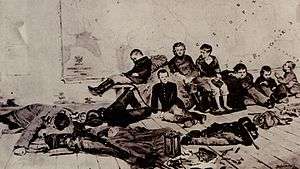Polish minority in Russia
There are currently 73,000 Polish nationals living in the Russian Federation. This includes autochthonous Poles as well as those forcibly deported during and after World War II; the total number of Poles in what was the former Soviet Union is estimated at up to 3 million.
Before 1917

Many Poles were exiled to Siberia, starting with the 18th-century opponents of the Russian Empire's increasing influence in the Polish-Lithuanian Commonwealth (most notably the members of the Bar Confederation).[1] After the change in Russian penal law in 1847, exile and penal labor (katorga) became common penalties to the participants of national uprisings within the Russian Empire. This led to increasing number of Poles being sent to Siberia for katorga, they were known as Sybiraks. Some of them remained there, forming a Polish minority in Sibera. Most of them came from the participants and supporters of the 19th century November Uprising and January Uprising,[2][3] the participants of the 1905-1907 unrest[3] to the hundreds of thousands of people deported in the Soviet invasion of Poland in 1939.[3]
There were about 20,000 Poles living in Siberia around the 1860s.[3] An unsuccessful uprising of Polish political exiles in Siberia broke out in 1866.[3]
In the late 19th century there was also a limited number of Polish voluntary settlers, attracted by the economic development of the region.[3] Polish migrants and exiles, many of whom were forbidden to move away from the region even after finishing serving their sentence, formed a vibrant Polish minority there.[3] Hundreds of Poles took part in the construction of the Trans-Siberian Railway.[3] Notable Polish scholars studied in Siberia, among them Aleksander Czekanowski, Jan Czerski, Benedykt Dybowski, Wiktor Godlewski, Sergiusz Jastrzebski, Edward Piekarski, Bronisław Piłsudski, Wacław Sieroszewski, Mikołaj Witkowski and others.[3]
In the Soviet Union
_(Kazimir_Malevich).jpg)
Millions of Poles lived within the Russian Empire as the Russian Revolution of 1917 started followed by the Russian Civil War. While some Poles associated with the communist movement, the majority of the Polish population saw cooperation with Bolshevik forces as betrayal and treachery of Polish national interests.[4] Marian Lutosławski and his brother Józef, the father of the Polish composer Witold Lutosławski, were murdered in Moscow in 1918 as "counter-revolutionaries".[5] Stanisław Ignacy Witkiewicz lived through the Russian Revolution in St. Petersburg, which had a profound effect on his works, many of which displayed themes of the horrors of social revolution. Famous revolutionaries with Polish origins include Konstantin Rokossovsky, Julian Marchlewski, Karol Świerczewski and Felix Dzerzhinsky, founder of the Cheka secret police which would later turn into the NKVD. However, according to their ideology they did not identify as Poles or with Poland, and members of the communist party viewed themselves as Soviet citizens without any national sentiments. The Soviet Union also organized Polish units in the Red Army and a Polish Communist government-in-exile.
In modern Russia

There were 73,000 Polish nationals living in Russia in 2002.[6] This includes autochthonous Poles as well as those forcibly deported during and after World War II; the total number of Poles in what was the former Soviet Union is estimated at up to 3 million.[7] The number of Polish speaking people in Russia was 47,125 in 2010.
See also
References
- ↑ Norman Davies, Europe: A History, Oxford University Press, 1996, ISBN 0-19-820171-0, Google Print, p.664
- ↑ (English) Dennis J. Dunn (2004). The Catholic Church and Russia: Popes, Patriarchs, Tsars, and Commissars. London: Ashgate Publishing. p. 57. ISBN 0-7546-3610-0.
- 1 2 3 4 5 6 7 8 9 Jerzy Jan Lerski, Piotr Wróbel, Richard J. Kozicki, Historical Dictionary of Poland, 966-1945, Greenwood Publishing Group, 1996, ISBN 0-313-26007-9, Google Print, 538
- ↑ J. M. Kupczak "Stosunek władz bolszewickich do polskiej ludności na Ukrainie (1921–1939)Wrocławskie Studia Wschodnie 1 (1997) Wydawnictwo Uniwersytetu Wrocławskiego , 1997 page 47–62" IPN Bulletin 11(34) 2003
- ↑ "::4lomza.pl:: Regionalny Portal". Mpd.4lomza.pl. Retrieved 2012-02-05.
- ↑ "Всероссийская перепись населения 2002 года". Perepis2002.ru. Retrieved 2012-02-05.
- ↑ Gil Loescher (8 August 1996). Beyond charity: international cooperation and the global refugee crisis. Oxford University Press. pp. 119–. ISBN 978-0-19-510294-9. Retrieved 5 February 2012.